 A Flat Horizon
A Flat Horizon
It may be the stuff of legend or urban myth, but despite the story’s vintage, and its wanting a valid basis, it is worth retelling. It begins with an engineer, soldering iron in hand, doing some bench-work, probably prototype wiring.
Somehow, the engineer’s soldering iron is said to have made contact with the needle of a syringe containing ink of species unknown. He probably would not have noticed but the needle apparently gave a little burp and ejected from its tip a blob of ink.
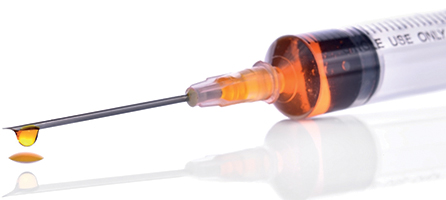
A chance meeting of a soldering iron and a hypodermic needle is said to have produced the first inkjet droplet
We do not know where the ink landed, whether it was casually wiped up or was left to dry and be forgotten. We do not know anything about the physical parameters that delivered what transpired to be a fortunate accident. But what we do know is that it got the engineer’s attention and he did it again—this time deliberately. He got the same result and inkjet printing, so it is told, found its genesis.
In order to make the discovery useful, lots of very gutty invention was needed. Tiny drops of ink in isolation are pretty useless, but millions of them can form an image. Ejecting millions of droplets when and where wanted proved to be a challenge. As events have since proved, the challenges were met and exceeded by the ancestors of the technology that today gives us some incredibly versatile inkjet printing hardware.

Tiny drops of ink in isolation are pretty useless, but millions of them can form an image”
Ever since that first blob landed, various interests have been trying to find a safe home for printed inkjet ink. Early efforts were focused on paper or paper-like materials and the development of a means to deal with the water in the inks and limit the effects of light on colourants. Lots of material coatings came and then inks based on solvents. Later still, UV inks threw a hat into the ring and the world took notice that these formulations achieved something quite notable—they did not require the substrate to be somewhat soluble in the ink’s carrier, they relied instead on other modes of adhesion.
Having the means to grip onto all manner of uncoated and somewhat inert surfaces meant that UV ink could be printed upon all manner of substrates. That basic model of versatility found its way forward in what was then an emerging new hardware form factor—we know it today as the flatbed printer; it is now here, and it is here to stay. ‘Flatbeds’, with very few exceptions, deliver UV cured inks to the substrates and surfaces they print.
Taking the basic promise of inks that appear to stick to most things, and a printer format that, in turn, allows many of those things to be placed in or on it, flatbeds are frequently described as ‘versatile’. They are; they allow all manner of otherworldly materials to be bought together into productive and creative alliances with digital ink.
Flatbed printers neatly sidestep some of the post printing processes needed to get roll materials applied to rigid substrates because those same substrates are printed directly. There is a money and time saving argument that many have made wrapped up in that flatbed characteristic capability.
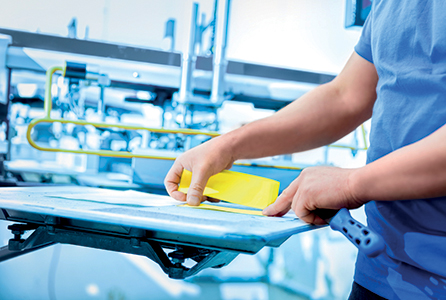
Print is no stranger to flatbed print hardware. Lots of digital presses have filled the void left by screen printing
Flatbeds even handle more in the way of roll materials than printers expressly designed for roll materials can. They do not notice heavy surface textures that would upset even the best friction feed mechanics. They just print whatever is put on the bed for them to print.
Sat somewhere in the middle of the flatbed and roll-fed printer categories is something the printer industry has branded a hybrid. It has what amounts to a section of moving flatbed usually fronted and trailed by removable sections designed to serve as feed-in and feed-out tables. The basic idea is, a moving belt, comprising the flatbed section, gets traction on the material its printing and moves it through the throat of the printer. It is a great idea and there is a role for it. No pun intended…
Flatbed printers have the potential to be extremely accurate. Typical designs move an array of print heads over the substrate in two directions. The heads are mounted in a carriage on a beam and the head-carriage assembly traverses that beam. The beam in turn is mounted on rails above the printer’s bed and it moves over the bed’s extent. In moving either component, the printer ‘knows’ where it is. Provided the ink can be jetted without significant deflection, and provided the substrate has not moved, the drop will be placed very accurately. Roll-fed printers introduce the potential for other orders of inaccuracy that are rarely noticed in a print but are there anyway.
Flatbeds deliver considerable utility to print companies that do or will make a living dealing with a lot of flat, rigid materials and graphical content. Now that white ink components are commonplace among flatbeds and hybrids, coloured substrates can be printed directly and such output can be widely deployed without concerns for durability.
The population of flatbed hardware in the market is considerable. The demand from the market that has driven its installation is considerable too and nowhere near anything that might be considered saturated. Printers are no stranger to flatbed printing of course. The population of digital flatbeds is to some extent filling the void vacated by screen presses.
Creative potential elevates the debate even further and ever more inventive ways of using flatbeds are explored daily by commercial printers moving to wide-format and among the longer established user fraternity in the sign industry. For the most part, users of roll-fed hardware are denied a seat at this meeting and many of them seek to expand their production assets as a consequence. Flatbed sales are ever-present and the need for the hardware underpins a story of growth.
The flatbed printer story is not complete without considering what makes the hardware the production powerhouse it is. As productive as it is, a flatbed serves to stuff ever more output into the narrow throat of one of the most constricted production bottlenecks known to wide format print producers. Images printed on rigid sheet material rarely come off the bed of the printer ready to use—they demand finishing.
Start with the finish
If a flatbed printer throws a jab, the follow-up punch comes from another part of the production floor where you will find a digital cutter. Digital cutters put co-extensive cuts around imaged matter so that it can then be displayed or used as a component in a fabricated assembly such as a point-of-sale unit. Without a digital cutter, a flatbed printer simply feeds the workforce with potentially complex manual finishing jobs—and it does so at pace.
Many commercial printers will have had occasion to chop a piece of print into an abstract-shaped flat form that, with the addition of some creasing, can then be formed into a useful article. The thump of a clicker or platen press though in this role has been drowned out in recent years by the whoosh of digital cutters, which do the job without costly origination or cutting dies. Dieless cutters are here and they love flatbed printers.
Before getting to print hardware in any detail, it helps to consider options for dealing with the output that the printer part of the equation deals with. In rather the same fashion a Rolls Roller delivers an orders of magnitude productivity and quality improvement to a roll-fed printer user, a digital cutter liberates the flatbed printer owner. It is one of those things that users say they genuinely could not manage without.

A digital cutter liberates the flatbed printer owner”
The hardware market understands the need and print finishing hardware, or ‘digital cutters’, as they are popularly known are available in a wide range of species and capabilities.
A typical digital cutter that rubs shoulders in a commercial printer’s premises with a flatbed printer will be a flatbed itself for reasons that are probably obvious. It will have an accommodating bed, a beam that traverses the bed, and an array of tools it can play over the loaded material. Tools may include knives for cutting flexible material and lighter rigid boards including foamed PVC. It may have a creasing tool, or several, so it can help make folded assemblies. It may have a spindle so that it can cut heavier rigid sheets that have come off the flatbed printer and which cannot be easily processed with a knife.
O Factoid: UV curing regimes based around LED energy sources consume much less electricity, while UV-based inks introduce digital print to a much wider range of substrates. O
Key to working with a flatbed printer in a print finishing context is some means of registering the printed output with the finishing hardware’s notion of where it needs to cut. This is accomplished with cameras built into the finishing hardware, and register marks printed by the printer. When printing is finished, the printed sheet is taken to the digital cutter and the system then ‘sniffs-out’ the register marks and compares the positions to where it thinks they should be. It will detect errors. Next, it makes internal adjustments and then cuts the output in tight register and ready for use.
Among the leading providers of digital cutters for print finishing operations are Zünd and Kongsberg. These systems help deliver to commercial print producers making the leap to wide-format the full potential of a flatbed printer and they help add considerable value to the output they produce. In addition to the ability to finish print, Zünd and Kongsberg hardware give a very good account of themselves as film-cutting devices too. They are fast, much faster than any manual operation, and quality is exemplary.
In considering options for finishing, a relative newcomer that defines in many ways a novel concept in the field should not be overlooked. Protek’s Unico TT, a digital cutter from Complete CNC Solutions, is a fully fleshed out and extremely productive digital cutter that dispatches mountains of print finishing tasks. But where that raw talent ends, another begins. The Unico TT in addition to being a leading digital cutter, is also a fully muscled production router capable of demolishing massive routing workloads too. Sat alongside a modern flatbed printer, it represents awesome productive and creative potential.
With a means to deal with all the raw production a flatbed printer can generate, the printers offer themselves in a wide range of capabilities. It pays to consider, when choosing a flatbed printer, not just the present-day imperative to print on a bit of flat material. Consider too, all you could do, all you might get asked for, and where your naked ambition to penetrate and then dominate the inviting world of wide-format print might take you. Buy something under-dimensioned or of indifferent pedigree and you will certainly live to regret the decision.
Hybrid formats
Ambition starts somewhere and even the biggest finds an entry or mid-level offering when it looks. If EFI Vutek and its towering reputation for producing some of the print industry’s biggest and fastest print hardware gets your attention, you will be happy to learn that it has mid-level flatbed/hybrid products too. Consider its H1625, for example.
The H1625 is a good example of the hybrid format hardware which delivers ticks in all the boxes most that are looking to print on rigid materials require. It is a four-colour printer that offers white ink too. White enables printing upon coloured and clear substrates and greatly enhances the reach of the commercial printer in terms of finding profitable markets and applications.
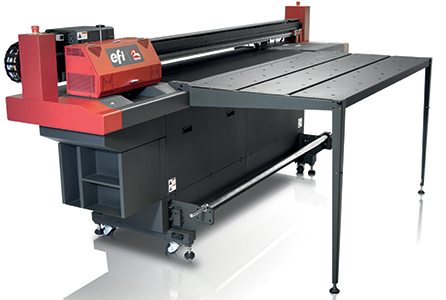
Hybrid printer configurations typically have a run-off and feed table arrangement to handle output off the driven belt
The H1625 will satisfy those with a need for quality too. It has all sorts of smarts for managing the way it delivers ink to the target substrate and so hits the magical ‘near photographic’ quality strata others target and that moves the whole plot into the realms of the remarkable when you consider that it prints on practically anything that can be put through its very accommodating throat.
On that subject, the H1625 will swallow sheet materials up to about 50mm thick and print a full bleed about 1.6m wide. Before consigning the ability to print such thick material to the “we will never get asked for that” bin, consider what you could be offering your market. You can, or could, print on sheets of birch ply with this clever printer. It looks amazing. If your printed birch ply were on the desk of a hundred shop-fitters tomorrow morning, would you get a call from some wanting to know more? Let’s settle for ‘probably’ while thinking a bit more about the unit’s versatility.
With an H1625 in the shop, and with a means to deal with all the output it will churn out, it is fair to say that you will be saying ‘yes’ to most, if not all of the work that turns up at the door. With its, and the flatbed breed’s capability in general, being at your disposal, you have the muscle needed to bring digital print into alliance with all manner of materials. You could become the person who is known for printing skies on ceiling tiles or adding a blush of colour to window blinds. There is so much you can do with a flatbed and an H1625 will not leave you wanting if you have got the temperament of an experimenter.

Flatbeds bring digital print into alliance with all manner of materials”
EFI Vutek is not alone in provisioning the converging sign and commercial print industries with printers that answer to the ‘hybrid’ format descriptor, there are many others out there too. Look for manufacturers with a legacy and moreover with a network that can extend support and keep the unit operating at its full potential. For the most part, you will not be taking a spanner to a flatbed printer yourself and having access to those who can is critical. Consider support as being as palpable a feature as the on-off switch. If it is not there, walk away.
Minting machines
Mention print hardware and getting into wide-format and many commercial print producers will join their sign-making brethren, and evoke Roland DG for very good reason. The company is a print industry pioneer; it has a huge installed base of print hardware and it is more than capable of moving the industry into entirely new space thanks to its innovations’ reach and capability. Roland’s Versa LEF-200 series printers do just that. The LEF-200 is a personal format flatbed that prints objects too.
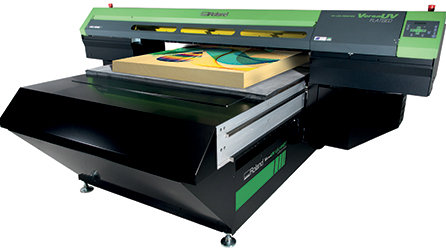
Roland DG’s application extending flatbed take digital print to places way beyond the horizon defined by wide-format in general. They will take your business there too
The LEF-200 sits in the middle of a range of printers defined by size. The 200 has a maximum print area of about 500mm by 300mm and, although relatively small, it is within this confined universe that some great things can happen.
There is room enough in the LEF printers’ maws to load other than flat objects. Add to that a tolerance for irregular surfaces and the ability to print on inert materials and you have a formula that takes flatbed printers into a new part of the application envelope where jaw-dropping value added potential turns everyday objects into high-value personalised products.
Applications for the LEF series are perhaps not what spring readily to the minds of those scouting the flat horizons for commercial opportunities but they should provoke thought. Given that most of the customers the commercial printers attract with output from flatbed printers are looking for the means to promote something, the LEF series sits comfortably adjacent to that need and able to propose all manner of inventive ways of delivering the goods.
Like most Roland developments, the LEF series is bristling with very clever feature that make the very clever things it does possible. One such example is management of the ink the unit jets. A consequence of jetting ink onto abstract shaped objects is that, sometimes, the ink will fly off at odd tangents to the object in a spray-like formation of droplets with nowhere to go. Inside Roland’s world and inside this Roland printer, that is not acceptable. LEF printers, therefore, do a great job of removing errant ink before it lands anywhere it should not. It works.
LEF printers use a low temperature curing system. All UV inks need to ‘cure’ so as to stabilise the ink on the substrate and render it durable. The LEF employs an LED array with the job of dealing with the cure. It turns liquid ink into something dry and hard on the substrate by kicking off internal reactions in the chemistry. Best not ask exactly how this works, but be glad it does. With the right primer printed and a suitable means to hold the object of the printer’s attention, there is little you cannot print on with an LEF on the bench. That is a thinly veiled recipe for keeping lots of customers entertained and happy, and lots of profit pouring in.
Roland fields a more conventionally configured system in the shape of its LEJ 640FT. This versatile flatbed takes a print load weighing up to a hundred kilos and as much as 6? in height. It has a point to make; if you can load it with an object its capable of handling, chances are the object can emerge from the other side of the experience highly personalised and worth much more than it was before the printer worked its magic. Wide-format printing is not all wall-coverings and vehicle graphics. The road to profitable applications is signposted by printers like the LEJ and LEF.
Hybrids and minting machines like the Roland LEF and LEJ aside, there is another broad category making up the numbers in the flatbed population. You might think of this as the ‘flatbed proper’. It is a flatbed that answers to the name flatbed, looks like a flatbed and is, surprise, a flatbed. The pure flatbed most closely resembles the hardware that kicked off the genre in the first place.
Pure flatbeds
Pure flatbeds carry some baggage around. They hail from the days when pioneering effort produced them and the results they produced sometimes looked like the ink might have been troweled on. Ugly piles of petrified pigment competing with prodigious swaths of overspray rendered output that had to be excused by viewing it at a great distance. To many commercial printers, this output did not even look like print. Under the glass, it dissolved into a confused looking expanse of rough terrain caked in something hoping to pass for ink. Somehow, it resolved itself into an image, but it just was not good enough for an educated eye that was expecting to see obedient dots.
But that was then. Today’s pure flatbed printers are still capable of giving materials a good hosing with ink, but they print with considerably more finesses than they ever have. The route they take to assembling a coherent image is a different one to that you will find on an offset press, but its a route that yields highly marketable output that nobody is going to shun in the growing sphere of its many applications.
Hailing from Switzerland, Swiss Q Print has taken the fundamental element of the flatbed print hardware formula and produced a range of hardware that exemplifies just how far behind us now the endearing characteristics of earlier flatbed hardware really are. Stand anyone who has not seen a flatbed printer for a while in front of one of Swiss Q Print’s products and expectation very quickly get realigned with today’s reality.
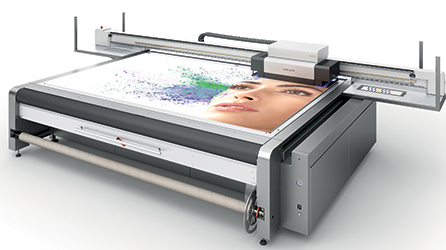
The Swiss Q Print Nyala LED takes the understood meaning of ‘versatility’ further. It can comfortably operate in markets as demanding as fine art
The company’s Nyala LED unit is a flatbed capable of putting ink, exactly where it is needed, over an area with horizons not reached in a space over 3 x 2m at speeds topping 200sq m/h. That number eases back as quality hits the upward curve and, if you dial in the best of everything you are looking at just over 30sq m/h. To put this emphatically into today’s perspective though, that is 30sq m you can sell into applications bordering fine art.
The Nyala LED, as at least part of its branding suggests, employs an LED curing regime to deal with the processes rendering its output durable. This delivers a couple of very bankable benefits users of the hardware, and the wider world should welcome. The LEDs deliver an energy saving dimension to the printer that sees it consuming half the resources of conventionally powered printers. That blue-white light that does the job can actually claim to be somewhat green then.
The Nyala’s economical curing regime gets there by seeing off the searing heat conventional curing regimes have to live with. As heat retreats, the number of substrates that can be printed advances. Materials that would literally curl up and fail on a lesser flatbed behave themselves on the Nyala and just sit there while the heads deliver the ink. That greatly expands the application universe of the basic flatbed formula and can lead to some stunning results.
In Swiss Q Print’s world, the prints feature almost like a hub around which spins an array of options that can help the printer and its owner to great heights of efficiency and productivity. Among them is ‘Rob’, a robot that will sit there all day loading flat sheet materials into the printer effectively turning serious production into a more-or-less hands-off proposition with minimal operator involvement.
Helpful features just made to make Swiss Q Print flatbeds more productive abound. Little ‘bungs’ can be inserted into strategic locations within the expanse of the bed defining new or multiple origins. This helps the user get more use out of the flat real-estate and fully exploit the extent of its horizons.
The Nyala is capable of producing output that requires a rethink in terms of its quality. It knows how to deliver ink in precisely metered quantities and to deposit it exactly where the RIP ordains and the substrate expects to see it. That pushes the application strata into the arena crossing the borders into fine art. Seen though a commercial printer’s end of the telescope, this represents compelling food for thought.
The Nyala pushes right out into the extreme corners of today’s print-performance envelope. ‘Versatility’ is a word that is so easily said and its meaning lost as a consequence. Dwell upon it though and a picture emerges. With the Swiss Q Print Nyala aboard, the fundamentals that drive commercial printers toward flatbeds are fully satisfied. It could print on sliced bread if someone could sell the reason for doing so. The Nyala, thanks to it ‘versatility’ does it all and then some. This one press helps a commercial printer deliver an unbelievable range of output and services.
Make it fast
Printers, and sign-makers for that matter, have always had what many might regard as an odd relationship with speed when it comes to production hardware. Sit down and do the sums, and the sums will tell you that, in order to get most of the production needed out of the way and delivered, most hardware is completely over-specified. Does not seem to matter. We are all impressed by whoosh-factor and we like our hardware fast.
Mimaki’s latest venture in flatbed printing hardware is just that. It is about two-and-a-half times faster than the printer it kicks off the throne and it answers to the name of JFX500-2131, or at least the JFX variation we are discussing does.
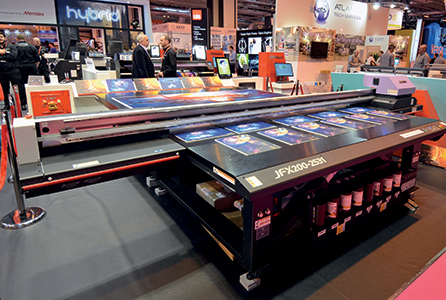
Mimaki’s big flatbed can print really tiny text and anything else it is called upon to do. It takes digital print to countless substrates and new markets
The big JFX is another flatbed in the wider-horizons class and it comfortably swallows up materials measuring 2 x 3m. It will not blink if something up to 50mm thick turns up on the work roster and it will cover it with great looking print at up to 60sq m/h.
In terms of party tricks, Mimaki knows a few as might be expected of a manufacturer with its legacy in inkjet printing. Among the JFXs best is MAPS, that is the pet name for the printer’s Mimaki Advanced Pass System. MAPS does a great job of magicing away banding that lesser hardware might leaving in conspicuous view on output. It works by imposing a gradation mask that influences the pace of curing in a tactical way. The result is print that looks nothing less than itself. Nothing detracts from the content.
Like other members of the ‘proper’ flatbed club, the big Mimaki is all about opening doors to new applications—the very reason most commercial printers want to get something going in the world of wide-format. Putting gorgeous images on a huge range of substrates does just that. There are markets and established demand to be satisfied in retail, domestic, and industrial applications. There are new markets to be discovered.

Like other members of the ‘proper’ flatbed club, the big Mimaki is all about opening doors to new applications”
The JFX is able to deal with white ink. That is something regarded as prerequisite among many in the flatbed club. It means the printer can work its magic on coloured and clear substrates. It also means that the more inventive of its users can use the capability to pilot further alliances of digital print and substrate. Wood, metal, and coloured plastics all have fallen to JFX equipped printers.
Mimaki challenges engineering conventions in flatbed printing by calling out the capability of the JFX in terms of its printing text down to two points. That is very small text, and that is a very large printer, making a very big point. Resolution of that kind of order means that this big flatbed can be applied to tasks that were until recently utterly beyond the capability and design intent of big flatbeds. Again it calls upon us to think again what ‘versatility’ really means. Mimaki, of course, has its view, and the JFX about sums it up.
Flatbed print hardware comes in all sorts of shapes and sizes and can take commercial printers and their businesses into markets that are growing, profitable, and that do not rely on the consumption of paper-based content. These are markets that place a premium on quality and which value technical expertise and execution.
If you are an energetic company looking to the wide-format sector and wondering if the time is right, look a little further. The hardware that you need to liberate your business could be moving into view just over the flat horizon. Go explore.
Your text here...